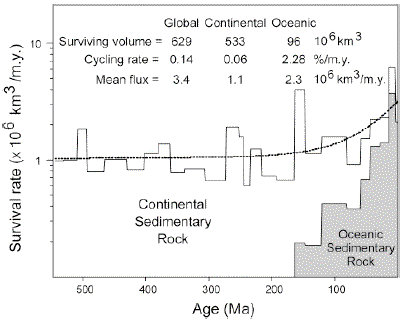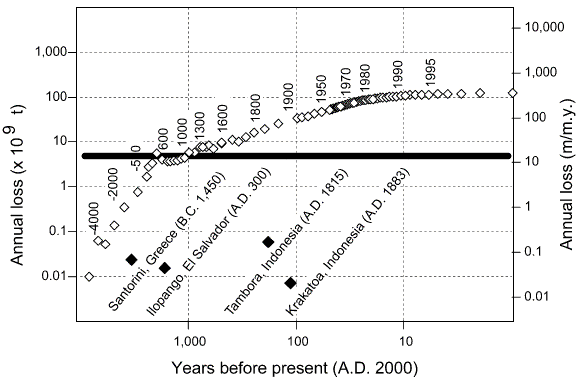Wilkinson(2005)による〔『Humans as geologic
agents: A deep-time perspective』(161p)から〕
『地質学的な力としての人間:長期的な観点から』
『Abstract
Humans move increasingly large amounts of rock and sediment during
various construction activities, and mean rates of cropland soil
loss may exceed rates of formation by up to an order of magnitude,
but appreciating the actual importance of humans as agents of
global erosion necessitates knowledge prehistoric denudation rates
imposed on land surfaces solely by natural processes. Amounts
of weathering debris that compose continental and oceanic sedimentary
rocks provide one such source of information and indicate that
mean denudation over the past half-billion years of Earth history
ha lowered continental surfaces by a few tens of meters per million
years. In comparison, construction and agricultural activities
currently result in the transport of enough sediment and rock
to lower all ice-free continental surfaces by a few hundred meters
per million years. Humans are now an order of magnitude more important
at moving sediment than the sum of all other natural processes
operating on the surface of the planet. Relationships between
temporal trends in land use and global population indicate that
humans became the prime agents of erosion sometime during the
latter part of the first millennium A.D.
Keywords: denudation; erosion; humans; deep time.』
Introduction
Global Phanerozoic sediment fluxes
River basin sediment loads
Humans as geologic agents
Conclusions
Acknowledgments
References cited
|

Figure 1. Data from Ronov (1983) on volumes of sediment
of given age deposited on oceanic (shaded) and continental (unshaded)
crust. Dashed line is best-fit model of decrease in global volume
of sedimentary rock under assumptions that mean
oceanic and continental sediment fluxes are 1.1 and 2.3×106
km3/m.y., respectively ( y-intercepts), and sediment
destruction by subduction and erosion of 2.28%/m.y. and 0.06%/m.y.,
respectively (see text).

Figure 2. Continental denudation rates for epoch-long
intervals determined from compositions of sedimentary rocks in
Ronov (1983) and fluxes and cycling rates in Figure 1. Terrigenous
debris makes up 69% and chemically precipitated phases are 31%
of current 630×106 km3 of rock in global
Phanerozoic sedimentary reservoir.

Figure 3. Historical rates of anthropogenic erosion (open
diamonds) from data in Hooke (2000a). For comparison, solid black
diamonds are volumes of several large volcanic eruptions (dates
in parentheses); heavy black line is mean deep-time denudation
rate of 24 m/m.y. determined from Figure 2.
|
Hooke,R.,LeB.(2000a): On the history of humans as geomorphic
agents. Geology, 28, 843-846.
Ronov,A.B.(1983): The Earth's sedimentary shell: Quantitative
patterns of its structure, compositions, and evolution. American
Geological Institute Reprint Series, 5, 1-73.
戻る


